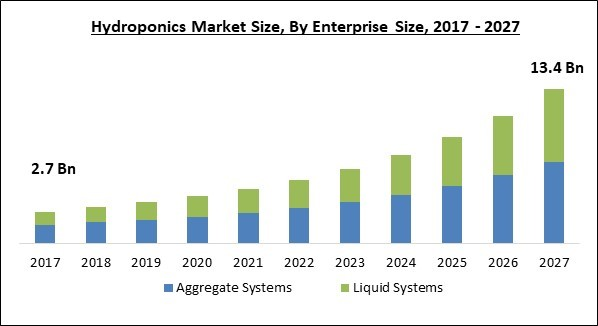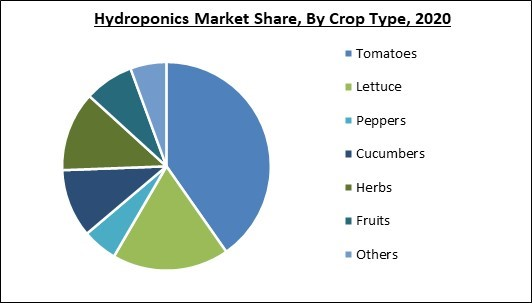The Global Hydroponics Market size is expected to reach $13.4 billion by 2027, rising at a market growth of 19.2% CAGR during the forecast period.
Hydroponic farming is a practice of growing without soil in which a mineral solution is introduced all around plant roots to substitute the earth. The plant roots are soaked in the chemical solution and monitored on regular intervals to maintain that the proper chemical composition for growth is sustained. As a result, infections caused by soil organisms are eliminated using the hydroponics technology. Furthermore, due of good nutrition management, hydroponically grown plants generate a better yield than equivalent plants cultivated in soil.
When cultivated under the same conditions, a hydroponic plant grows 3050 percent quicker than a soil one. In a hydroponic system, nutrients are processed with water before being delivered to the root system. Furthermore, because hydroponic farming uses nutritional solutions all of the time, it saves water than soil based cultivation. Hydroponics requires simply fertilizers, water, and sunlight to allow plants to grow much better with their roots submerged in water.
The pipe network comprising submerged plant roots allows nutrient-rich water to pass through it. Plants are cultivated in a controlled environment with the right temperature, relative humidity, light, nutrients, and water. This method is used in a region where there is a scarcity of cultivable land. For agricultural cultivation, hydroponics saves both land and water. Hydroponics may be used to cultivate a variety of crops, including vegetables, fruits, and flowers.
The global need for food is increasing as the world's population grows. According to the United Nations' Food and Agriculture Organization (FAO), the global population is predicted to achieve 9.1 billion by 2050, with food production projected to rise by 25 percent to 70 percent. This is expected to increase demand for alternative agricultural methods that provide large yields in a shorter amount of time. Alternative High-yield farming technologies are increasingly being used in markets like Asia Pacific and Europe, where agricultural land and water have become scarce, which is predicted to promote market growth.
COVID-19 Impact Analysis
Many people have formed a negative attitude about outside food as a result of the Covid-19 outbreak. With health and food safety taking center stage, people all around the world are gravitating toward home cooking and self-made/homemade meals. The food and lodging industries have been put in peril as a result of this. Following the horrific emergence of the coronavirus pandemic, the rate of adoption of urban hydroponic farming systems is expected to skyrocket over the world.
During the early stages of the pandemic, the agriculture industry encountered difficulties. On the farm, there were severe labor shortages, several farmers lost their harvesting period for seasonal crops, agricultural product prices were dropping, and logistics were disrupted. Many countries also realized that they were overly reliant on food imports and began focusing on local and internal production.
Market Growth Factors:
Innovative hydroponic technologies are being developed
Manufacturers and academics are attempting to improve the efficiency of hydroponics technology to raise the quality and quantity of product as the technique becomes more widely adopted. Many firms in the industry are extensively investing in R&D in order to gain cutting-edge technology that will increase output while also allowing for a wider diversity of cultivations. The expansion of the hydroponics industry is aided by strategic alliances with research laboratories and institutions.
Hydroponic farming is gaining popularity among vegetable growers since it is a labor-saving approach for managing large production areas and an effective method for regulating inputs and managing pest and disease management. Farmers are embracing hydroponics because it reduces the need for soil fumigants and can increase the yields of popular vegetables. The introduction of hydroponics as a favored farming method is boosting the sector's growth.
Food products cultivated naturally are becoming more popular than those developed traditionally
Consumers are becoming more aware of the basic components utilized in food items, as well as their origins. Consumers are increasingly selecting sustainable and chemical-free food items as their understanding of health and fitness grow. As a result, customers have grown increasingly eager to spend money on organic and natural food products in order to maintain a healthy lifestyle. Farmers are turning to organic hydroponics solutions in response to the rising demand for organic food. Fruits and organic vegetables are grown under hydroponics are preferred by food makers.
Aided with the growing knowledge of the existence of dangerous additives and chemicals in food goods, naturally grown food products are favored over conventionally grown ones. Natural-grown items, such as food produced in hydroponic systems, are preferred by buyers because they are devoid of toxic pesticides, chemicals, and additives.
Marketing Restraining Factor:
Large-scale farms require a significant amount of capital
The hydroponics industry's biggest disadvantage is the high cost of this technology. However, it is expected that a lot of research and development activities in this subject will lower the total cost of this technology. The sector's expansion is being accelerated by a growing emphasis on food security, high profitability, and expanding consumption of exotic vegetables and salad.
A hydroponic farm's main cost elements are HVAC systems, ventilation, fans, control systems, irrigation systems, railways, and lighting, among others.
The high initial cost of setting up the system is a big deterrent to farmers investing in these systems. However, these methods provide larger yields, and the food may also be marketed as luxury items, increasing the return on investment for producers.
Type Outlook
Based on Type, the market is segmented into Aggregate Systems and Liquid Systems. In 2020, the aggregate systems had the major market share because to their broad acceptance among all indoor hydroponic growers due to their simplicity of setup and low cost. Plants are supported in these systems by inert and solid media like as peat, vermiculite, rock wool, sawdust, sand, perlite, or coconut coir. Drip systems, wick systems and ebb and flow systems, are the most common technologies used in aggregation systems. The most prevalent mode of an aggregate system is ebb and flow, which is favoured because it is simple and inexpensive to construct.
Crops Outlook
Based on Crops, the market is segmented into Tomatoes, Lettuce, Peppers, Cucumbers, Herbs, Fruits, and Others. The tomatoes category led the market in terms of market size in 2020. Tomatoes are the most widely hydroponically produced crops in the world, owing to their quick growth rate and lower water requirements than conventionally farmed tomatoes. For tomato hydroponic production, the indoor farmers employ perlite, rock wool, or coconut coir as growth materials. By 2028, hydroponic technology is expected to be used to grow the largest number of tomatoes in Europe and Asia Pacific.
Regional Outlook
Based on Regions, the market is segmented into North America, Europe, Asia Pacific, and Latin America, Middle East & Africa. Due to the widespread use of hydroponics in China, South Korea, Australia, and other Asian nations, the Asia Pacific region will be one of the top hydroponics markets in 2020. Due to the emergence of urban hydroponic farms, the market in India and China is likely to grow considerably throughout the forecast period.
The market research report covers the analysis of key stake holders of the market. Key companies profiled in the report include Argus Control Systems Limited, The Scotts Miracle-Gro Company, American Hydroponics, LumiGrow, Inc., Emerald Harvest, Hydroponic Systems International, Hydrofarm Holdings Group, Inc., HydroGarden Ltd., Signify N.V., and Heliospectra AB.
Scope of the Study
Market Segments Covered in the Report:
By Type
- Aggregate Systems and
- Liquid Systems
By Crops
- Tomatoes
- Lettuce
- Peppers
- Cucumbers
- Herbs
- Fruits
- Others
By Geography
- North America
- US
- Canada
- Mexico
- Rest of North America
- Europe
- Germany
- UK
- France
- Russia
- Spain
- Italy
- Rest of Europe
- Asia Pacific
- China
- Japan
- India
- South Korea
- Singapore
- Malaysia
- Rest of Asia Pacific
- LAMEA
- Brazil
- Argentina
- UAE
- Saudi Arabia
- South Africa
- Nigeria
- Rest of LAMEA
Key Market Players
List of Companies Profiled in the Report:
- Argus Control Systems Limited
- The Scotts Miracle-Gro Company
- American Hydroponics
- LumiGrow, Inc.
- Emerald Harvest
- Hydroponic Systems International
- Hydrofarm Holdings Group, Inc.
- HydroGarden Ltd.
- Signify N.V.
- Heliospectra AB
Unique Offerings from the Publisher
- Exhaustive coverage
- The highest number of market tables and figures
- Subscription-based model available
- Guaranteed best price
- Assured post sales research support with 10% customization free
Table of Contents
Companies Mentioned
- Argus Control Systems Limited
- The Scotts Miracle-Gro Company
- American Hydroponics
- LumiGrow, Inc.
- Emerald Harvest
- Hydroponic Systems International
- Hydrofarm Holdings Group, Inc.
- HydroGarden Ltd.
- Signify N.V.
- Heliospectra AB
Methodology

LOADING...










